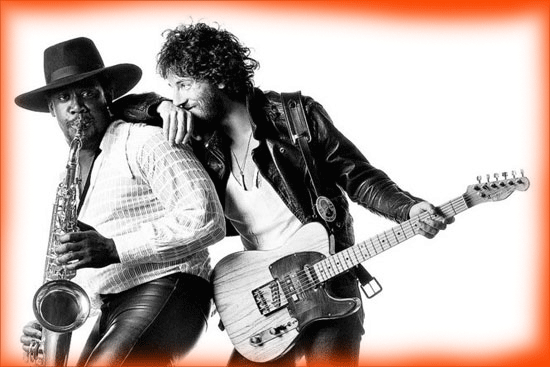http://www.youtube.com/watch?v=5e4-20tqC4A
Bruce Springsteen’s long time sax player and friend of 40 years, Clarence Clemons, died on Saturday.
If Bruce was the obvious heart of the E-Street Band, Clarence was its soul.
We who are longtime fans all have our favorite iconic Clarence moments. The three-minute sax solo in Jungleland, that seemed to grow, if anything, more powerful as the years progressed.
And, during the 80’s, when the band played Thunder Road, after the sax solo that took the song to its feverish end, Clarence and Bruce would kiss. This was no timid guy-to-guy lip peck, but a passionate embrace; a deliciously ecstatic moment that was repeated night after night without its power lessening.
Clarence also has always had a musical life away from Springsteen, as is demonstrated below as Clemons plays with Dr. John, and in his recent presence on two of Lady Gaga’s new tracks, plus his appearance in her Edge of Glory video.
But it was Springsteen and Clemons who were the lifelong musical soul mates.
Part way into every concert The Boss would introduce the E-Street Band. It was always his intro of his sax player that was the most extravagant and that inevitably brought down the house.
Just to be clear, Clemons was a wonderful tenor sax player, but there are those who were technically better. Yet one cannot possibly find a rock horn player more beloved. When he played Springsteen’s music in particular, his affect was outsized, majestic, and deeply emotional. David Remnick of the New Yorker has put it well:
Clemons, who died Saturday of complications from a stroke, was not an entirely original player—he was a vessel of many great soul, gospel, and R&B players who came before him—but he was an entirely sublime band member, an absolutely essential, and soulful, ingredient in both the sound of Springsteen and the spirit of the group. Clemons will be irreplaceable; Sonny Rollins could step in for him and never be able to provide the same sense of personality and camaraderie. His horn gave the band its sound of highway loneliness, its magnificent heart. And his huge presence on stage was an anchor for Springsteen, especially when Bruce was younger, scrawny, and so feral, so unleashed, that you thought that he could fall down dead in a pool of sweat at any moment. At the brink of exhaustion and collapse, Springsteen could always lean on his enormous and reliable friend—an emblematic image that is the cover of “Born to Run.”
This is from Springsteen’s own statement about his friend, confirming that Clarence had died:
His loss is immeasurable and we are honored and thankful to have known him and had the opportunity to stand beside him for nearly forty years. He was my great friend, my partner, and with Clarence at my side, my band and I were able to tell a story far deeper than those simply contained in our music.
A story far deeper. Yes. Exactly.
And listen: during these days as we allow news of the death of The Big Man to sink in, perhaps the loss can best be explained by the fact that, whenever the E-Street Band played—and collectively sang—what I believe is Springsteen’s most beautiful, and certainly his most mature love song, “If I Should Fall Behind,” when it came time for Bruce to sing the last verse, which he usually performed as part of a duet, he always sang it—not to his gorgeous, red-headed wife Patti Scialfa—but to the 6’5″ black guy with the horn and the dreds, who towered on stage with soulful splendor just to The Boss’s right.
Should we lose each other
In the shadow of the evening trees
I’ll wait for you
And should I fall behind
Wait for me
Photo by Eric Meola, shot on June 20, 1975

